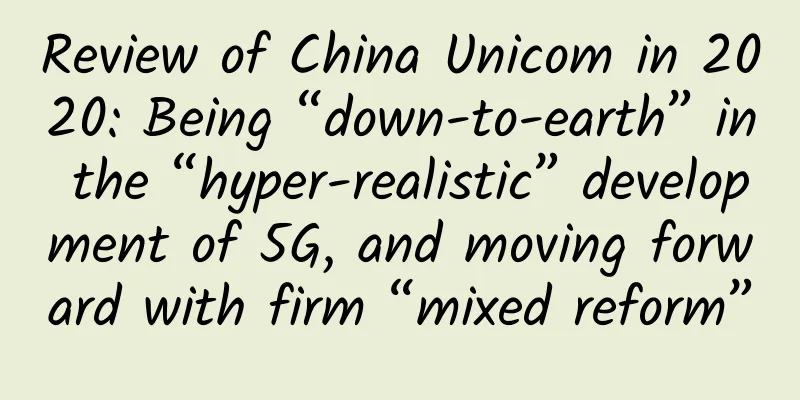Review of China Unicom in 2020: Being “down-to-earth” in the “hyper-realistic” development of 5G, and moving forward with firm “mixed reform”

|
As a technology that can rewrite the rules of the game, 5G has developed rapidly in China and the global market in 2020. 5G terminals have flourished, and 5G applications that empower thousands of industries have emerged in an endless stream.
Looking back at 2020, China Unicom's focus on 5G development is on two aspects: 5G application innovation and 5G network construction. However, unlike the industry's pace, China Unicom's 5G application innovation has the ability to "monetize", and 5G network sharing and co-construction has also achieved three "world firsts" and created a "Beijing model". It can be said that in the "super-realistic" development of 5G in 2020, China Unicom's 5G development is more intensive and down-to-earth, which "coincides" with China Unicom's firm high-quality development route. In 2020, China Unicom's "mixed-ownership reform" will continue to "turn the blade inward". Whether it is the reform of the large-scale market coordinated operation organization system or the mixed-ownership reform of Guangxi Unicom... As China Unicom Chairman Wang Xiaochu said, "China Unicom was born out of reform and innovation, and will surely become stronger through reform and innovation." In 2021 and beyond, China Unicom will continue to firmly move forward with "mixed-ownership reform". Industry understanding makes 5G "monetary" 5G has opened a new chapter in 2B. In terms of 2B, the value that operators can obtain is very high. According to the forecast made by GSMA and Ericsson, the value of the entire 2B side should be 1.3 trillion US dollars in 2026, of which more than 700 billion US dollars are available to operators. While the industry is still exploring 5G industry applications, China Unicom's 5G industry applications have begun to "monetize". Previously, Jing Lei, product director of the Industrial Internet BU of the Government and Enterprise Customer Business Group of China Unicom Group and an expert in the Industrial Internet, said in an interview with C114 that he was "very optimistic" about the development prospects of "5G+Industrial Internet". In his view, more companies are willing to pay for the Industrial Internet, which also means that 5G+Industrial Internet has the ability to realize cash, which means that the industry is gradually moving towards a healthy development track. "The key for enterprises to choose partners lies in industry understanding, and this is China Unicom's strength." In 2020, China Unicom showed "accelerated" development in the industrial field, and continued to deepen its presence in aviation manufacturing, mining, clothing, steel, home appliances, equipment, electricity, petrochemicals and other industries and achieved positive results. In fact, this is closely related to the "double upgrade" of China Unicom's organizational structure and platform system. In terms of personnel organization structure, China Unicom has begun to make drastic changes to build the strongest team for the development of the industrial Internet. Jing Lei revealed that China Unicom has established an industrial Internet BU under the government, enterprise and institution group, and provinces and some cities with relatively developed industries have also established local industrial Internet BUs, realizing the three-level connection from headquarters to provinces to cities, and uniformly allocating resources across the country to provide customers with integrated, comprehensive, reliable and timely services from marketing, support to implementation. In terms of capabilities, relying on the cloud network foundation, we have created a self-developed + ecological product system of "two networks, one platform, and one cloud". "Two networks" refers to the industrial intranet and extranet. China Unicom has launched 5G virtual private networks, hybrid private networks, and independent private networks. China Unicom has launched the CUII bearer network in the industrial extranet, based on which SDN transformation is realized, providing customers with one-point cloud access and elastic networking services. "One platform" is a reflection of China Unicom's platform strategy, integrating the capabilities of Yundi Wisdom's industrial cluster platform, edge cloud platform, and equipment networking platform to propose an AIoT platform. "One cloud" is an ecological cloud that integrates self-developed SaaS capabilities and third-party capabilities into this cloud, and connects the ecosystem through unified standards. After the "double upgrade" of organizational structure and platform system, China Unicom's expansion in the field of industrial Internet has become more aggressive. In 2020, China Unicom released three categories of 5G industrial private networks and continued to promote the implementation of cloud networking products based on high-quality industrial external networks; helped high-end manufacturing companies build 6I fully connected factories; realized remote control at Baowu Zhangang; and used industrial intelligent middle platforms to realize intelligent quality inspection and compliance analysis at companies such as Youngor, Luoyang First Tractor, Liheng Steel, and Coca-Cola. The development of China Unicom's 5G+Industrial Internet is only a microcosm of the rapid development of China Unicom's 5G applications. In the industry's view, the application of 5G 2B in 2020 is trial commercial or partially commercial, but it has not really started to scale. In 2021, 5G will definitely have large-scale commercial landing in these industry applications. However, large-scale commercialization is actually difficult for a single company to do, and it must be based on the win-win development of cooperation with our ecological partners. China Unicom has made preparations in this regard. The 5G Application Innovation Alliance, which it has taken the lead in establishing, has now brought together more than 1,000 industry chain partners and has made breakthrough progress in the fields of industrial Internet, smart medical care, smart education, security, AR/VR, etc. Facing the new starting point in 2021, China Unicom is willing to work with industry partners to promote 5G to play a greater role in enabling high-quality development, creating high-quality life, and achieving high-efficiency governance through three aspects of efforts. 5G co-construction and sharing have achieved success For operators, the overall development of the mobile communications industry has entered a low-growth stage, and business revenue has not increased significantly. However, 5G is indeed an asset-heavy product that requires large investments. Since 5G was officially put into commercial use, China Unicom has resolutely implemented the new development concept put forward by the Party Central Committee, and is jointly building the world's first 5G co-construction and sharing network with China Telecom. While overcoming adverse effects such as the epidemic, it completed the annual 5G construction target one quarter ahead of schedule and achieved basic 5G network coverage in major urban areas of cities above the prefecture level across the country. Wang Xiaochu, Chairman of China Unicom, said that joint construction and sharing saved both parties more than 60 billion yuan in construction investment, basically achieved the rapid formation of 5G network coverage capabilities in the shortest time and with the least investment, and laid a solid network foundation for cultivating and unblocking the "big cycle" of the domestic 5G industrial chain, supply chain, and value chain. In fact, after a year of exploration in 2020, the co-construction and sharing of China Telecom and China Unicom has brought valuable experience to the industry and the whole society. Miao Shouye, head of China Unicom's 5G co-construction and sharing working group, mentioned that China Unicom and China Telecom's 5G co-construction and sharing have achieved three "world firsts": the world's first and largest co-construction and sharing 5G network, the world's first 200MHz large-bandwidth high-performance 5G network, and the world's first TDD+FDD hybrid networking 5G network. In terms of cost savings, co-construction and sharing also brings real results. Miao Shouye pointed out that through co-construction and sharing, the construction and operation costs of 5G networks have been significantly reduced, and the TCO savings have been significant. After the sharing of telecommunications networks, CAPEX is expected to be reduced by about 40%, and OPEX by about 35% each year. In addition, taking Beijing as an example, data shows that in 2019, Beijing Unicom and Beijing Telecom were the first in the country to realize full sharing of 5G NSA networks. In 2020, the two parties continued to work closely together and took the lead in realizing full sharing of 5G SA networks and 4G networks. The two parties now have 15,000 5G base stations in Beijing. In order to achieve the best investment return ratio, Beijing Unicom strictly controls the target areas and base station distribution of 5G construction. At the same time, Beijing Unicom also attaches great importance to internal innovation and potential tapping, and improves 5G benefits through network optimization. Through innovative 5G optimization and potential tapping, the benefits are improved by more than 10%. Through 5G maintenance and potential tapping, Beijing Unicom's 5G network maintenance level has fully reached or even exceeded the 4G maintenance level to a certain extent. The improvement in invisible benefits brought by this aspect alone has also increased by more than 10%. In addition to the innovation of 5G co-construction and sharing, Beijing Unicom has made innovations in every node of network planning, construction, optimization, and maintenance to achieve the investment and construction effect of 5G. The "Beijing Model" created by China Unicom is actually the best "example" of the value and innovation brought by 5G co-construction and sharing. Recently, Xiao Yaqing, Minister of Industry and Information Technology, said that in 2021, 5G network construction and application will be promoted in an orderly manner, 5G coverage in major cities will be accelerated, co-construction and sharing will be promoted, and more than 600,000 5G base stations will be built. In 2021, China Unicom will continue to deepen cooperation with China Telecom in co-construction and sharing to promote high-quality 5G network construction. In addition, in order to further enhance the confidence and motivation of industry ecosystem partners, China Unicom will also actively strengthen all-round co-construction and sharing in the fields of 4G indoor distribution, computer rooms, optical fibers, pipelines, etc. with China Telecom to further enhance network competitiveness and company value. Firmly moving forward with mixed ownership reform China Unicom is a product of the telecommunications system reform, and reform is the main theme of the company's growth and expansion. From today's perspective, China Unicom's mixed ownership reform is a landmark event. Because this is the most powerful reform since the new round of SOE reform. The sale of more than 30% of the equity, the large-scale participation of many Internet companies, the complex investment methods, the reorganization of the board of directors, and the change of the corporate governance structure all show that this is a typical example of wading into deep waters, and a classic case of success and failure. In 2020, China Unicom's mixed-ownership reform will continue to "turn the blade inward". In March, China officially launched the reform of the large-market coordinated operation organization system. At the headquarters level, an operation organization system with "1 department and 2 centers" as the core was established. "1 department" means that the marketing department will be the planner and resource coordinator of the large market system, responsible for the overall coordination and organization of the front and back ends of the market. "2 centers" means establishing a "product center" and a "channel operation center" under the coordination of the large market. The main goal of this reform is to focus on the construction of eight major capabilities, including customer value management, brand building and communication, product innovation, omni-channel operation, middle platform, big data, ecological cooperation, and finance, to form a differentiated advantage. On May 19, China Unicom's mixed-ownership reform made further efforts and went deeper. Guangxi Unicom and its three partners, Beijing Telecommunications Engineering Bureau Co., Ltd., Huakong Zhongrui Holdings Investment Management Co., Ltd., Anhui China Electric Xingfa and Xinlong Technology Co., Ltd., signed the "Guangxi Unicom Social Cooperation Operation Comprehensive Reform Cooperation Agreement", officially launching the social reform work in seven cities, including Liuzhou, Baise, Wuzhou, Hechi, Laibin, Qinzhou and Guigang. Of course, no reform can be achieved overnight, and mixed ownership reform will not work just by mixing. As Wang Xiaochu said, state-owned capital and non-state-owned capital have different characteristics and demands, and we cannot just stop at the appearance of "mixing". We must seek the greatest common divisor, form a complete industrial chain, and unify state-owned capital and private capital to liberate and develop social productivity, fully integrate and superimpose the respective advantages of state-owned and private enterprises, mix them to achieve the greatest chemical reaction, and reform them to achieve the greatest vitality. After the mixed-ownership reform, China Unicom has been focusing on high-quality development, and its operating performance is obvious to all. In terms of innovative business, in the first three quarters, Unicom's industrial Internet business revenue was 32.656 billion yuan, up 34.4% year-on-year; driven by the rapid growth of innovative business, fixed-line service revenue reached 89.057 billion yuan, up 12.9% year-on-year. It can be said that as a model of mixed-ownership reform in the telecommunications industry, China Unicom has played a role as a bridgehead for the entire telecommunications industry after years of mixed-ownership reform. It is not difficult to predict that with strong policy support, the continuous support of "mixed-ownership reform", and the wave of 5G empowering vertical industries, China Unicom's "five new" goals will eventually be achieved, and the prospects are still worth looking forward to! "China Unicom was born out of reform and innovation, and will surely become stronger through reform and innovation." In 2021, China Unicom will continue to deepen its focus on innovative cooperation strategies, make every effort to stabilize basic businesses, enhance the core capabilities of government and enterprise businesses, enhance the development momentum of innovative businesses, and ensure steady growth of the company. At the same time, it will deepen the reform of mixed ownership, give full play to its differentiated advantages, and steadily promote the transformation and upgrading of business, channels, networks, IT support, and resource allocation, promote modernization of governance through comprehensive digitalization, and strive to achieve high-quality and healthy development. |
>>: Digital city, 5G is just the appetizer
Recommend
Graphic: A brief history of router architecture
Over the past 50 years, we’ve made a lot of progr...
Implementation comparison and practice of distributed computing engines Flink/Spark on k8s
The underlying resource management platform of di...
my country has built 718,000 5G base stations, and 5G+ industrial Internet is developing rapidly
Xiao Yaqing, Minister of Industry and Information...
DMIT: Hong Kong CN2 GIA/US CN2 GIA line large bandwidth VPS quarterly payment starting from US$28.8
DMIT.io is a foreign hosting company established ...
Edge networks are evolving towards intelligence and computing enhancement
"Always on, always connected" has becom...
The rise of the NetOps engineer
NetOps, also known as NetDevOps, is the practice ...
Network Slicing "Hot Pot Theory": Same Pot, Different Dreams
In the dog days of summer, when people are "...
Introduction and solution of TCP sticky packet and half packet (Part 1)
In network transmission, sticky packets and half ...
5G: Base stations are being built crazily, but utilization rate cannot keep up, with only 3% coverage?
At present, the number of 5G base stations in Chi...
Briefly describe the four key indicators of network performance: bandwidth, latency, jitter, and packet loss rate
1. Bandwidth (1) Basic concepts Bandwidth refers ...
Teach you how to distinguish between single-mode and multi-mode optical fibers
Single mode fiber Single-mode fiber has a thinner...
5G speed is already incredible, is 6G network coming?
Now 4G network signals have been popularized all ...
Yunfan accelerates the "live broadcast +" SaaS solution to promote live broadcast into a new era
2016 is known as the "first year of online l...
Unleashing the potential of 5G: 5G millimeter wave enters the commercial sprint stage
2021 is the year when 5G will be popularized at a...
Huawei Cloud EI focuses on three basic research innovations to help industries upgrade to intelligence
On July 27, Huawei Cloud held the TechWave AI Day...

![[11.11] Maxthon Hosting: 25% off on all VPS, top up 111 yuan and get 111 yuan free, US CN2/Hong Kong CN2/Germany CN2/Netherlands CN2/Hong Kong High Defense, etc.](/upload/images/67cac23308ee6.webp)







